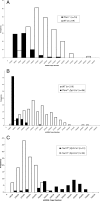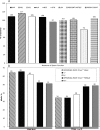The role of mitochondrial DNA copy number in mammalian fertility
- PMID: 20130269
- PMCID: PMC2888963
- DOI: 10.1095/biolreprod.109.080887
The role of mitochondrial DNA copy number in mammalian fertility
Abstract
Mammalian mitochondrial DNA (mtDNA) is a small, maternally inherited genome that codes for 13 essential proteins in the respiratory chain. Mature oocytes contain more than 150 000 copies of mtDNA, at least an order of magnitude greater than the number in most somatic cells, but sperm contain only approximately 100 copies. Mitochondrial oxidative phosphorylation has been suggested to be an important determinant of oocyte quality and sperm motility; however, the functional significance of the high mtDNA copy number in oocytes, and of the low copy number in sperm, remains unclear. To investigate the effects of mtDNA copy number on fertility, we genetically manipulated mtDNA copy number in the mouse by deleting one copy of Tfam, an essential component of the mitochondrial nucleoid, at different stages of germline development. We show that males can tolerate at least a threefold reduction in mtDNA copy number in their sperm without impaired fertility, and in fact, they preferentially transmit a deleted Tfam allele. Surprisingly, oocytes with as few as 4000 copies of mtDNA can be fertilized and progress normally through preimplantation development to the blastocyst stage. The mature oocyte, however, has a critical postimplantation developmental threshold of 40 000-50 000 copies of mtDNA in the mature oocyte. These observations suggest that the high mtDNA copy number in the mature oocyte is a genetic device designed to distribute mitochondria and mtDNAs to the cells of the early postimplantation embryo before mitochondrial biogenesis and mtDNA replication resumes, whereas down-regulation of mtDNA copy number is important for normal sperm function.
Figures






Comment in
-
Mitochondrial DNA copy number, a marker of viability for oocytes.Biol Reprod. 2010 Jul;83(1):1-2. doi: 10.1095/biolreprod.110.084269. Epub 2010 Mar 10. Biol Reprod. 2010. PMID: 20220127 Free PMC article. No abstract available.
References
-
- Gyllensten U, Wharton D, Josefsson A, Wilson AC.Paternal inheritance of mitochondrial DNA in mice. Nature 1991; 352: 255–257. - PubMed
-
- Schwartz M, Vissing J.Paternal inheritance of mitochondrial DNA. N Engl J Med 2002; 347: 576–580. - PubMed
-
- Zouros E.The exceptional mitochondrial DNA system of the mussel family Mytilidae. Genes Genet Syst 2000; 75: 313–318. - PubMed
-
- Kvist L, Martens J, Nazarenko AA, Orell M.Paternal leakage of mitochondrial DNA in the great tit (Parus major). Mol Biol Evol 2003; 20: 243–247. - PubMed
Publication types
MeSH terms
Substances
Grants and funding
LinkOut - more resources
Full Text Sources
Other Literature Sources
Molecular Biology Databases

